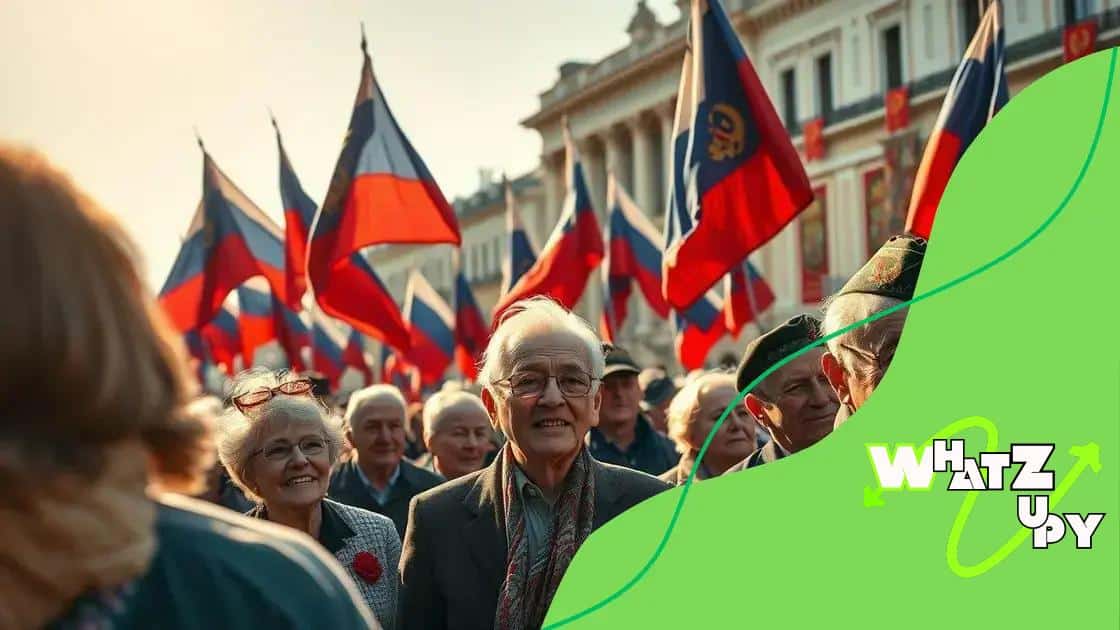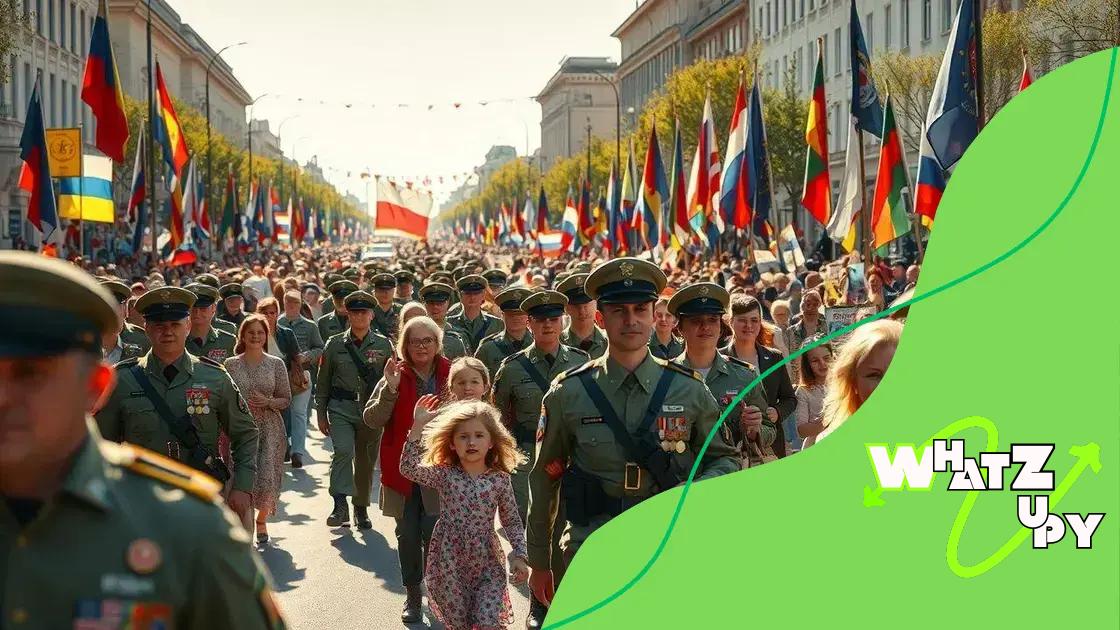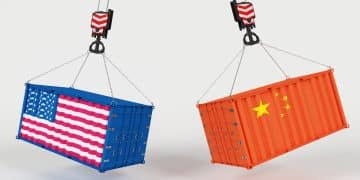Victory Day WWII May 8 2025: A Historic Celebration

Victory Day, celebrated on May 8, honors the end of World War II in Europe with ceremonies, parades, and community events that promote remembrance, peace, and inclusivity across nations.
Victory Day WWII May 8 2025 stands as a pivotal moment in history, inviting us to reflect on triumphs and sacrifices. What does this day mean for you and your community? Let’s explore the significance behind this historic celebration.
Understanding Victory Day and Its Significance
Understanding Victory Day is essential as it commemorates the end of World War II in Europe. This day is significant for many nations, particularly those involved in the struggle against fascism.
The observance of this day varies across countries, but its core message remains the same: to honor those who fought bravely. Throughout history, Victory Day has come to symbolize peace, freedom, and remembrance.
Importance of Commemorating Victory Day
Commemorating Victory Day brings communities together. It serves as a reminder of the sacrifices made by veterans and civilians alike. Unity is often showcased through ceremonies held in various towns and cities.
- Parades featuring veterans and military displays.
- Fireworks that light up the sky.
- Ceremonies that include moments of silence.
These events are not just celebrations; they are opportunities for people to reflect on history. The emotions tied to Victory Day remind us to appreciate the peace we have today.
Global Observances of Victory Day
Different countries observe this day in unique ways. For example, in Russia, May 9 is marked with grand festivities, including military parades through Red Square. Other nations also hold memorials and dedicate time to honoring their soldiers.
- International dialogues about peace and conflict resolution.
- Art exhibitions showcasing the effects of war.
- School programs educating children about history.
Through these activities, communities can foster an understanding and appreciation of the sacrifices made during the war. Victory Day transcends borders, reminding us of the importance of peace and cooperation.
Historical Context of WWII and Victory Day
Understanding the historical context of World War II and Victory Day helps us appreciate the significance of this important day. World War II was a global conflict that lasted from 1939 to 1945, involving many of the world’s nations.
Victory Day marks the surrender of Nazi Germany, officially ending the war in Europe on May 8, 1945. This event reshaped international relations and changed the political landscape worldwide.
Key Events Leading Up to Victory Day
Several crucial events led to the declaration of Victory Day. The Allies gained momentum through various battles, including significant victories at Stalingrad and D-Day. These turning points weakened Axis powers and paved the way for victory.
- The Battle of Stalingrad: A major turning point in 1943.
- D-Day: The Allied invasion of Normandy in 1944.
- The fall of Berlin in 1945: The final major offensive of the war.
As these events unfolded, the desire for peace grew stronger among nations. The horrors of war led to countless losses, emphasizing the need for unity and cooperation in rebuilding after the conflict.
The Aftermath of World War II
After the war, many countries began to adopt a policy of remembrance. Victory Day became a symbol of resilience and hope for a better future. Nations honored their veterans and reflected on the sacrifices made during the war. This remembrance also laid the foundation for future international agreements.
- The establishment of the United Nations in 1945.
- Initiatives for peacekeeping missions worldwide.
- Commemorative events to promote understanding of war’s impact.
As we observe Victory Day, it is essential to remember past struggles and strive for peace. Understanding this history helps us recognize the importance of harmony among nations today.
How Countries Commemorate Victory Day

Countries around the world celebrate Victory Day in various ways, honoring the sacrifices made during World War II. Each nation has its own traditions and events that reflect its history and culture.
For instance, in Russia, Victory Day is marked by grand military parades and fireworks. These festivities display national pride and respect for veterans. The streets are filled with people, and the air is alive with excitement as communities come together to celebrate.
Common Traditions on Victory Day
Many countries include specific customs to remember their heroes and educate future generations. Some common traditions include:
- Candlelight vigils to honor fallen soldiers.
- Parades showcasing military equipment and personnel.
- Public speeches reflecting on the impact of war.
In addition, various nations host exhibitions that focus on the stories of people who lived through the war. This allows younger generations to learn about their history and the importance of peace. Engaging the youth is a key aspect of commemorating Victory Day.
International Observances and Activities
Several nations participate in international observances of Victory Day, fostering a sense of unity. Activities such as art contests, community service, and conferences promote awareness of the war’s consequences and the importance of peace.
- Educational programs that highlight lessons learned from the war.
- International discussions on maintaining global peace.
- Multicultural events celebrating victory and togetherness.
As we observe the various ways countries commemorate Victory Day, it serves as a powerful reminder of resilience and the ongoing quest for understanding and collaboration among nations.
Traditions and Ceremonies on May 8
On May 8, countries commemorate Victory Day with a variety of traditions and ceremonies. These practices are rooted in history and reflect the collective memory of the sacrifices made during World War II. Each nation has developed unique ways to celebrate this important day.
One prevalent tradition is the organization of military parades. These parades feature soldiers, veterans, and military equipment, showcasing national pride. In cities across various countries, the streets are adorned with flags and flowers as people gather to honor those who served.
Common Ceremonial Practices
Ceremonies held on Victory Day often include several key elements that help to evoke national pride and remembrance. Some of these practices include:
- Moments of silence to remember fallen soldiers.
- Wreath-laying ceremonies at monuments dedicated to veterans.
- Public speeches from leaders reflecting on the impact of the war.
These ceremonies serve as poignant reminders of the cost of war and the value of peace. Additionally, many communities organize educational events that involve storytelling and sharing personal experiences from the war.
Festivals and Community Gatherings
In addition to formal ceremonies, Victory Day celebrations often include festivals and community gatherings. These events provide an opportunity for people to come together and celebrate freedom. Festivities can range from cultural performances to food fairs.
- Concerts featuring patriotic music.
- Cultural displays showcasing traditional dances and costumes.
- Family-friendly activities that engage the younger generation.
Such celebrations foster a sense of unity and connection among the people as they recognize their shared history. As communities honor the sacrifices of their ancestors, they also reinforce the value of peace and cooperation moving forward.
The Future of Victory Day Celebrations
The future of Victory Day celebrations looks bright as nations continue to honor their histories while adapting to modern times. As societies evolve, so do the ways in which we commemorate significant events like this one.
Many countries are increasingly recognizing the need to include more voices in the narratives surrounding Victory Day. This integration of diverse perspectives can make the celebrations more inclusive and meaningful for all generations.
Embracing Technology in Celebrations
As technology advances, it plays a significant role in the evolution of Victory Day celebrations. Events may incorporate virtual reality experiences, allowing people to immerse themselves in historical events. Online streaming of parades and ceremonies can connect people worldwide.
- Virtual events enabling global participation.
- Interactive historical exhibits accessible via mobile apps.
- Augmented reality experiences at memorial sites.
Such technological advancements can enhance understanding of the events leading up to Victory Day and provide richer, more engaging experiences for audiences.
Promoting Peace and Reconciliation
Future Victory Day celebrations will likely focus more on themes of peace and reconciliation. As nations come together on this day, leaders may emphasize the importance of learning from the past to avoid future conflicts. Programs aimed at fostering dialogue among different cultures can serve as key components of the celebration.
- Workshops promoting understanding and cooperation.
- Joint commemorative events with neighboring countries.
- Educational initiatives on the importance of peacekeeping.
Highlighting these themes ensures that Victory Day remains relevant, encouraging future generations to value peace and unity. Participation in such initiatives not only honors those who fought but also helps build a more harmonious world for everyone.
FAQ – Frequently Asked Questions About Victory Day Celebrations
What is the significance of Victory Day?
Victory Day commemorates the end of World War II in Europe, honoring the sacrifices made by soldiers and civilians.
How do countries celebrate Victory Day?
Countries celebrate with military parades, ceremonies, fireworks, and community events that honor veterans and promote unity.
What are some future trends for Victory Day celebrations?
Future celebrations may incorporate technology, focus on peace themes, and engage wider communities in events.
Why is it important to include diverse voices in celebrations?
Including diverse voices helps create a more inclusive narrative that honors all perspectives and ensures that the historical significance is shared among all communities.





